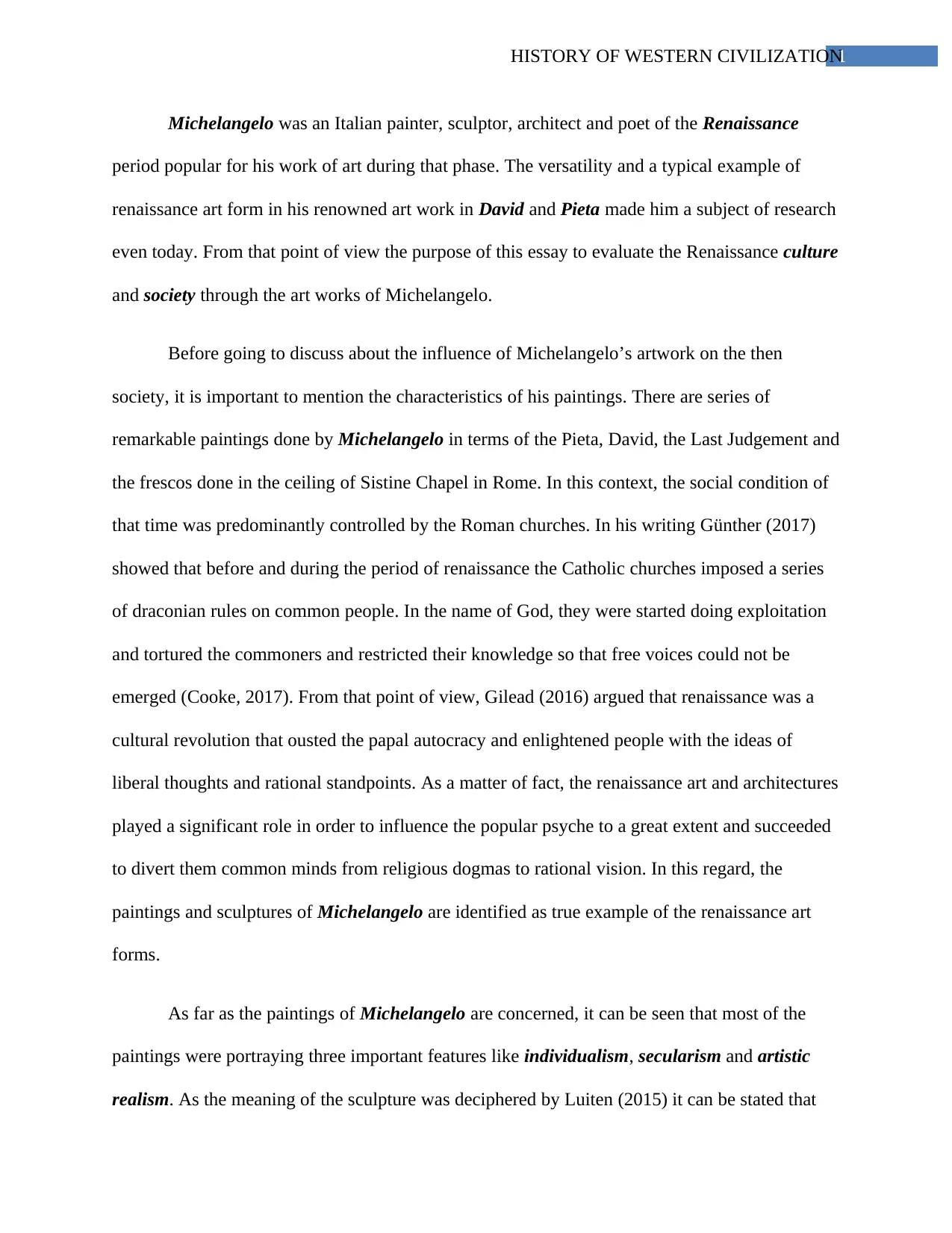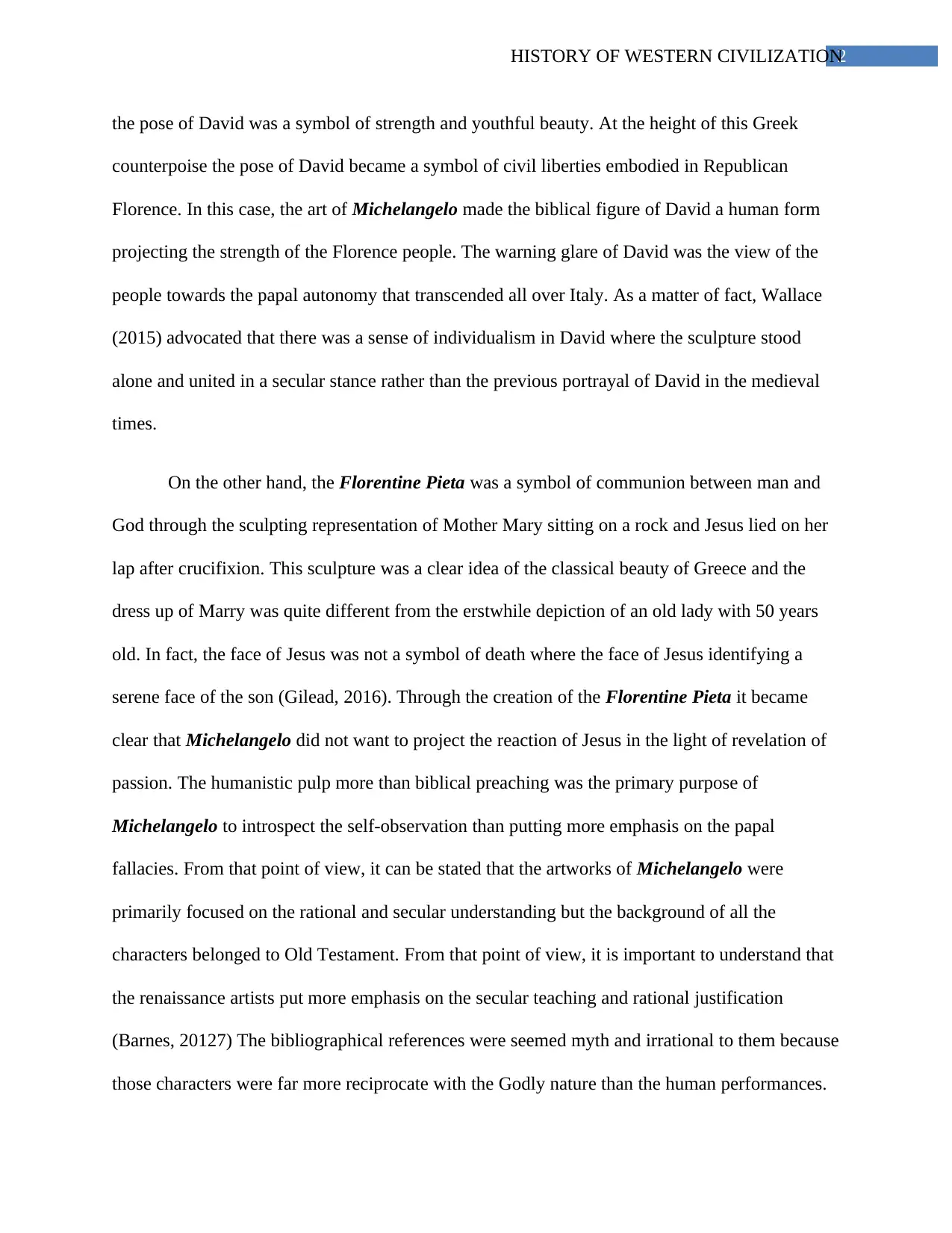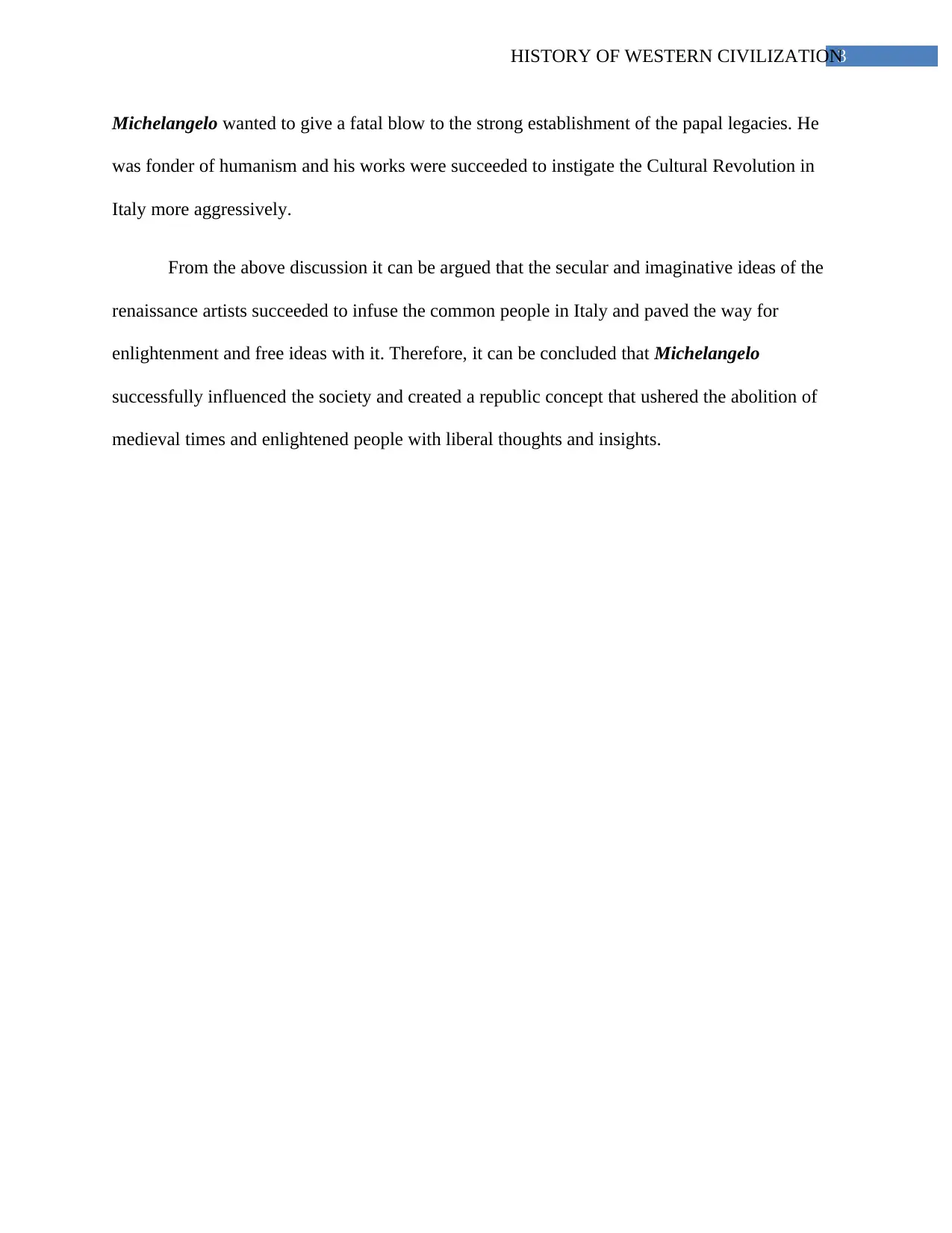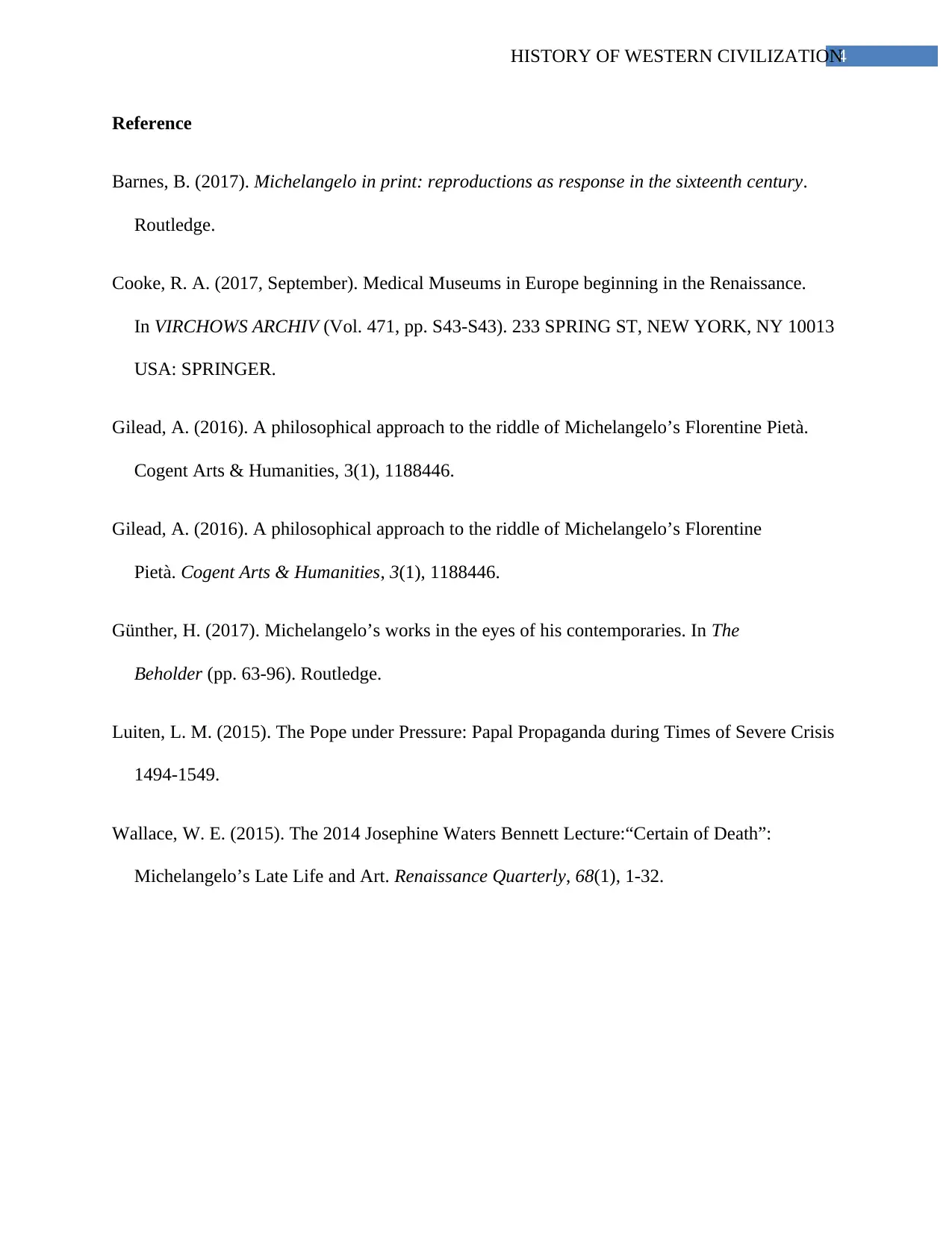The Impact of Michelangelo's Art on Renaissance Culture and Society
VerifiedAdded on 2021/10/28
|5
|1097
|154
Essay
AI Summary
This essay examines the influence of Michelangelo's artwork on Renaissance culture and society. The essay explores Michelangelo's notable works like David and Pieta, and their reflection of the era's shift from religious dogmas to rational thought, individualism, and secularism. It highlights how Michelangelo's art, characterized by individualism and secularism, challenged the dominance of the Roman Catholic Church and inspired a cultural revolution. Through the analysis of his sculptures, the essay demonstrates how Michelangelo's art influenced the societal transition, promoting humanism and paving the way for enlightenment and free ideas. The references provided support the discussion on the historical and cultural context of Michelangelo's art.

Running Head: HISTORY OF WESTERN CIVILIZATION
HISTORY OF WESTERN CIVILIZATION
Name of the Student:
Name of University:
Author Note:
HISTORY OF WESTERN CIVILIZATION
Name of the Student:
Name of University:
Author Note:
Paraphrase This Document
Need a fresh take? Get an instant paraphrase of this document with our AI Paraphraser

1HISTORY OF WESTERN CIVILIZATION
Michelangelo was an Italian painter, sculptor, architect and poet of the Renaissance
period popular for his work of art during that phase. The versatility and a typical example of
renaissance art form in his renowned art work in David and Pieta made him a subject of research
even today. From that point of view the purpose of this essay to evaluate the Renaissance culture
and society through the art works of Michelangelo.
Before going to discuss about the influence of Michelangelo’s artwork on the then
society, it is important to mention the characteristics of his paintings. There are series of
remarkable paintings done by Michelangelo in terms of the Pieta, David, the Last Judgement and
the frescos done in the ceiling of Sistine Chapel in Rome. In this context, the social condition of
that time was predominantly controlled by the Roman churches. In his writing Günther (2017)
showed that before and during the period of renaissance the Catholic churches imposed a series
of draconian rules on common people. In the name of God, they were started doing exploitation
and tortured the commoners and restricted their knowledge so that free voices could not be
emerged (Cooke, 2017). From that point of view, Gilead (2016) argued that renaissance was a
cultural revolution that ousted the papal autocracy and enlightened people with the ideas of
liberal thoughts and rational standpoints. As a matter of fact, the renaissance art and architectures
played a significant role in order to influence the popular psyche to a great extent and succeeded
to divert them common minds from religious dogmas to rational vision. In this regard, the
paintings and sculptures of Michelangelo are identified as true example of the renaissance art
forms.
As far as the paintings of Michelangelo are concerned, it can be seen that most of the
paintings were portraying three important features like individualism, secularism and artistic
realism. As the meaning of the sculpture was deciphered by Luiten (2015) it can be stated that
Michelangelo was an Italian painter, sculptor, architect and poet of the Renaissance
period popular for his work of art during that phase. The versatility and a typical example of
renaissance art form in his renowned art work in David and Pieta made him a subject of research
even today. From that point of view the purpose of this essay to evaluate the Renaissance culture
and society through the art works of Michelangelo.
Before going to discuss about the influence of Michelangelo’s artwork on the then
society, it is important to mention the characteristics of his paintings. There are series of
remarkable paintings done by Michelangelo in terms of the Pieta, David, the Last Judgement and
the frescos done in the ceiling of Sistine Chapel in Rome. In this context, the social condition of
that time was predominantly controlled by the Roman churches. In his writing Günther (2017)
showed that before and during the period of renaissance the Catholic churches imposed a series
of draconian rules on common people. In the name of God, they were started doing exploitation
and tortured the commoners and restricted their knowledge so that free voices could not be
emerged (Cooke, 2017). From that point of view, Gilead (2016) argued that renaissance was a
cultural revolution that ousted the papal autocracy and enlightened people with the ideas of
liberal thoughts and rational standpoints. As a matter of fact, the renaissance art and architectures
played a significant role in order to influence the popular psyche to a great extent and succeeded
to divert them common minds from religious dogmas to rational vision. In this regard, the
paintings and sculptures of Michelangelo are identified as true example of the renaissance art
forms.
As far as the paintings of Michelangelo are concerned, it can be seen that most of the
paintings were portraying three important features like individualism, secularism and artistic
realism. As the meaning of the sculpture was deciphered by Luiten (2015) it can be stated that

2HISTORY OF WESTERN CIVILIZATION
the pose of David was a symbol of strength and youthful beauty. At the height of this Greek
counterpoise the pose of David became a symbol of civil liberties embodied in Republican
Florence. In this case, the art of Michelangelo made the biblical figure of David a human form
projecting the strength of the Florence people. The warning glare of David was the view of the
people towards the papal autonomy that transcended all over Italy. As a matter of fact, Wallace
(2015) advocated that there was a sense of individualism in David where the sculpture stood
alone and united in a secular stance rather than the previous portrayal of David in the medieval
times.
On the other hand, the Florentine Pieta was a symbol of communion between man and
God through the sculpting representation of Mother Mary sitting on a rock and Jesus lied on her
lap after crucifixion. This sculpture was a clear idea of the classical beauty of Greece and the
dress up of Marry was quite different from the erstwhile depiction of an old lady with 50 years
old. In fact, the face of Jesus was not a symbol of death where the face of Jesus identifying a
serene face of the son (Gilead, 2016). Through the creation of the Florentine Pieta it became
clear that Michelangelo did not want to project the reaction of Jesus in the light of revelation of
passion. The humanistic pulp more than biblical preaching was the primary purpose of
Michelangelo to introspect the self-observation than putting more emphasis on the papal
fallacies. From that point of view, it can be stated that the artworks of Michelangelo were
primarily focused on the rational and secular understanding but the background of all the
characters belonged to Old Testament. From that point of view, it is important to understand that
the renaissance artists put more emphasis on the secular teaching and rational justification
(Barnes, 20127) The bibliographical references were seemed myth and irrational to them because
those characters were far more reciprocate with the Godly nature than the human performances.
the pose of David was a symbol of strength and youthful beauty. At the height of this Greek
counterpoise the pose of David became a symbol of civil liberties embodied in Republican
Florence. In this case, the art of Michelangelo made the biblical figure of David a human form
projecting the strength of the Florence people. The warning glare of David was the view of the
people towards the papal autonomy that transcended all over Italy. As a matter of fact, Wallace
(2015) advocated that there was a sense of individualism in David where the sculpture stood
alone and united in a secular stance rather than the previous portrayal of David in the medieval
times.
On the other hand, the Florentine Pieta was a symbol of communion between man and
God through the sculpting representation of Mother Mary sitting on a rock and Jesus lied on her
lap after crucifixion. This sculpture was a clear idea of the classical beauty of Greece and the
dress up of Marry was quite different from the erstwhile depiction of an old lady with 50 years
old. In fact, the face of Jesus was not a symbol of death where the face of Jesus identifying a
serene face of the son (Gilead, 2016). Through the creation of the Florentine Pieta it became
clear that Michelangelo did not want to project the reaction of Jesus in the light of revelation of
passion. The humanistic pulp more than biblical preaching was the primary purpose of
Michelangelo to introspect the self-observation than putting more emphasis on the papal
fallacies. From that point of view, it can be stated that the artworks of Michelangelo were
primarily focused on the rational and secular understanding but the background of all the
characters belonged to Old Testament. From that point of view, it is important to understand that
the renaissance artists put more emphasis on the secular teaching and rational justification
(Barnes, 20127) The bibliographical references were seemed myth and irrational to them because
those characters were far more reciprocate with the Godly nature than the human performances.
⊘ This is a preview!⊘
Do you want full access?
Subscribe today to unlock all pages.

Trusted by 1+ million students worldwide

3HISTORY OF WESTERN CIVILIZATION
Michelangelo wanted to give a fatal blow to the strong establishment of the papal legacies. He
was fonder of humanism and his works were succeeded to instigate the Cultural Revolution in
Italy more aggressively.
From the above discussion it can be argued that the secular and imaginative ideas of the
renaissance artists succeeded to infuse the common people in Italy and paved the way for
enlightenment and free ideas with it. Therefore, it can be concluded that Michelangelo
successfully influenced the society and created a republic concept that ushered the abolition of
medieval times and enlightened people with liberal thoughts and insights.
Michelangelo wanted to give a fatal blow to the strong establishment of the papal legacies. He
was fonder of humanism and his works were succeeded to instigate the Cultural Revolution in
Italy more aggressively.
From the above discussion it can be argued that the secular and imaginative ideas of the
renaissance artists succeeded to infuse the common people in Italy and paved the way for
enlightenment and free ideas with it. Therefore, it can be concluded that Michelangelo
successfully influenced the society and created a republic concept that ushered the abolition of
medieval times and enlightened people with liberal thoughts and insights.
Paraphrase This Document
Need a fresh take? Get an instant paraphrase of this document with our AI Paraphraser

4HISTORY OF WESTERN CIVILIZATION
Reference
Barnes, B. (2017). Michelangelo in print: reproductions as response in the sixteenth century.
Routledge.
Cooke, R. A. (2017, September). Medical Museums in Europe beginning in the Renaissance.
In VIRCHOWS ARCHIV (Vol. 471, pp. S43-S43). 233 SPRING ST, NEW YORK, NY 10013
USA: SPRINGER.
Gilead, A. (2016). A philosophical approach to the riddle of Michelangelo’s Florentine Pietà.
Cogent Arts & Humanities, 3(1), 1188446.
Gilead, A. (2016). A philosophical approach to the riddle of Michelangelo’s Florentine
Pietà. Cogent Arts & Humanities, 3(1), 1188446.
Günther, H. (2017). Michelangelo’s works in the eyes of his contemporaries. In The
Beholder (pp. 63-96). Routledge.
Luiten, L. M. (2015). The Pope under Pressure: Papal Propaganda during Times of Severe Crisis
1494-1549.
Wallace, W. E. (2015). The 2014 Josephine Waters Bennett Lecture:“Certain of Death”:
Michelangelo’s Late Life and Art. Renaissance Quarterly, 68(1), 1-32.
Reference
Barnes, B. (2017). Michelangelo in print: reproductions as response in the sixteenth century.
Routledge.
Cooke, R. A. (2017, September). Medical Museums in Europe beginning in the Renaissance.
In VIRCHOWS ARCHIV (Vol. 471, pp. S43-S43). 233 SPRING ST, NEW YORK, NY 10013
USA: SPRINGER.
Gilead, A. (2016). A philosophical approach to the riddle of Michelangelo’s Florentine Pietà.
Cogent Arts & Humanities, 3(1), 1188446.
Gilead, A. (2016). A philosophical approach to the riddle of Michelangelo’s Florentine
Pietà. Cogent Arts & Humanities, 3(1), 1188446.
Günther, H. (2017). Michelangelo’s works in the eyes of his contemporaries. In The
Beholder (pp. 63-96). Routledge.
Luiten, L. M. (2015). The Pope under Pressure: Papal Propaganda during Times of Severe Crisis
1494-1549.
Wallace, W. E. (2015). The 2014 Josephine Waters Bennett Lecture:“Certain of Death”:
Michelangelo’s Late Life and Art. Renaissance Quarterly, 68(1), 1-32.
1 out of 5
Your All-in-One AI-Powered Toolkit for Academic Success.
+13062052269
info@desklib.com
Available 24*7 on WhatsApp / Email
![[object Object]](/_next/static/media/star-bottom.7253800d.svg)
Unlock your academic potential
Copyright © 2020–2025 A2Z Services. All Rights Reserved. Developed and managed by ZUCOL.
